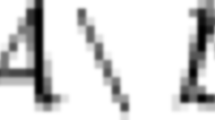Abstract
Quantization rate is a crucial measure of complexity in determining stabilizability of control systems subject to quantized state measurements. This paper investigates quantization complexity for a class of nonlinear systems which are subjected to disturbances of unknown statistics and unknown bounds. This class of systems includes linear stablizable systems as special cases. Two lower bounds on the quantization rates are derived which guarantee input-to-state stabilizability for continuous-time and sampled-data feedback strategies, respectively. Simulation examples are provided to validate the results.
Similar content being viewed by others
References
Åström K J, Kumar P R. Control: a perspective. Automatica, 2014, 50: 3–43
Delchamps D F. Stabilizing a linear system with quantized state feedback. IEEE Trans Autom Control, 1990, 35: 916–924
De Persis C. Nonlinear stabilizability via encoded feedback: the case of integral ISS systems. Automatica, 2006, 42: 1813–1816
De Persis C, Jayawardhana B. Coordination of passive systems under quantized measurements. SIAM J Control Optim, 2012, 50: 3155–3177
Elia N, Mitter S K. Stabilization of linear systems with limited information. IEEE Trans Autom Control, 2001, 46: 1384–1400
Fradkov A L, Andrievsky B, Ananyevskiy M S. Passification based synchronization of nonlinear systems under communication constraints and bounded disturbances. Automatica, 2015, 55: 287–293
Fu M Y, Xie L H. The sector bound approach to quantized feedback control. IEEE Trans Autom Control, 2005, 50: 1698–1711
Kameneva T, Nešić D. Input-to-state stabilization of nonlinear systems with quantized feedback. In: Proceedings of the 17th IFAC World Congress, Seoul, 2008. 12480–12485
Matveev A S, Savkin A V. Estimation and Control over Communication Networks. Boston: Birkhäuser, 2009
Wang L Y, Li C, Yin G G, et al. State observability and observers of linear-time-invariant systems under irregular sampling and sensor limitations. IEEE Trans Autom Control, 2011, 56: 2639–2654
Wong W S, Brockett R W. Systems with finite communication bandwidth constraints II: stabilization with limited information feedback. IEEE Trans Autom Control, 1999, 44: 1049–1053
Nair G N, Evans R J. Stabilization with data-rate-limited feedback: tightest attainable bounds. Syst Control Lett, 2000, 41: 49–56
Nair G N, Evans R J. Exponential stabilisability of finite-dimensional linear systems with limited data rates. Automatica, 2003, 39: 585–593
Tatikonda S, Mitter S. Control under communication constraints. IEEE Trans Autom Control, 2004, 49: 1056–1068
Liberzon D, Hespanha J P. Stabilization of nonlinear systems with limited information feedback. IEEE Trans Autom Control, 2005, 50: 910–915
Hayakawa T, Ishii H, Tsumura K. Adaptive quantized control for nonlinear uncertain systems. Syst Control Lett, 2009, 58: 625–632
Kang X L, Ishii H. Coarsest quantization for networked control of uncertain linear systems. Automatica, 2015, 51: 1–8
Liu K, Fridman E, Johansson K H. Dynamic quantization of uncertain linear networked control systems. Automatica, 2015, 59: 248–255
Zhou J, Wen C Y, Yang G H. Adaptive backstepping stabilization of nonlinear uncertain systems with quantized input signal. IEEE Trans Autom Control, 2014, 59: 460–464
Nair G N, Evans R J. Stabilizability of stochastic linear systems with finite feedback data rates. SIAM J Control Optim, 2004, 43: 413–436
Sahai A, Mitter S. The necessity and sufficiency of anytime capacity for stabilization of a linear system over a noisy communication link—Part I: scalar systems. IEEE Trans Autom Control, 2006, 52: 3369–3395
Tatikonda S, Sahai A, Mitter S. Stochastic linear control over a communication channel. IEEE Trans Autom Control, 2004, 49: 1549–1561
Brockett R W, Liberzon D. Quantized feedback stabilization of linear systems. IEEE Trans Autom Control, 2000, 45: 1279–1289
Liberzon D, Nešić D. Input-to-state stabilization of linear systems with quantized state measurements. IEEE Trans Autom Control, 2007, 52: 767–781
Author information
Authors and Affiliations
Corresponding author
Rights and permissions
About this article
Cite this article
Zheng, C., Li, L., Wang, L. et al. How much information is needed in quantized nonlinear control?. Sci. China Inf. Sci. 61, 092205 (2018). https://doi.org/10.1007/s11432-016-9172-4
Received:
Revised:
Accepted:
Published:
DOI: https://doi.org/10.1007/s11432-016-9172-4




